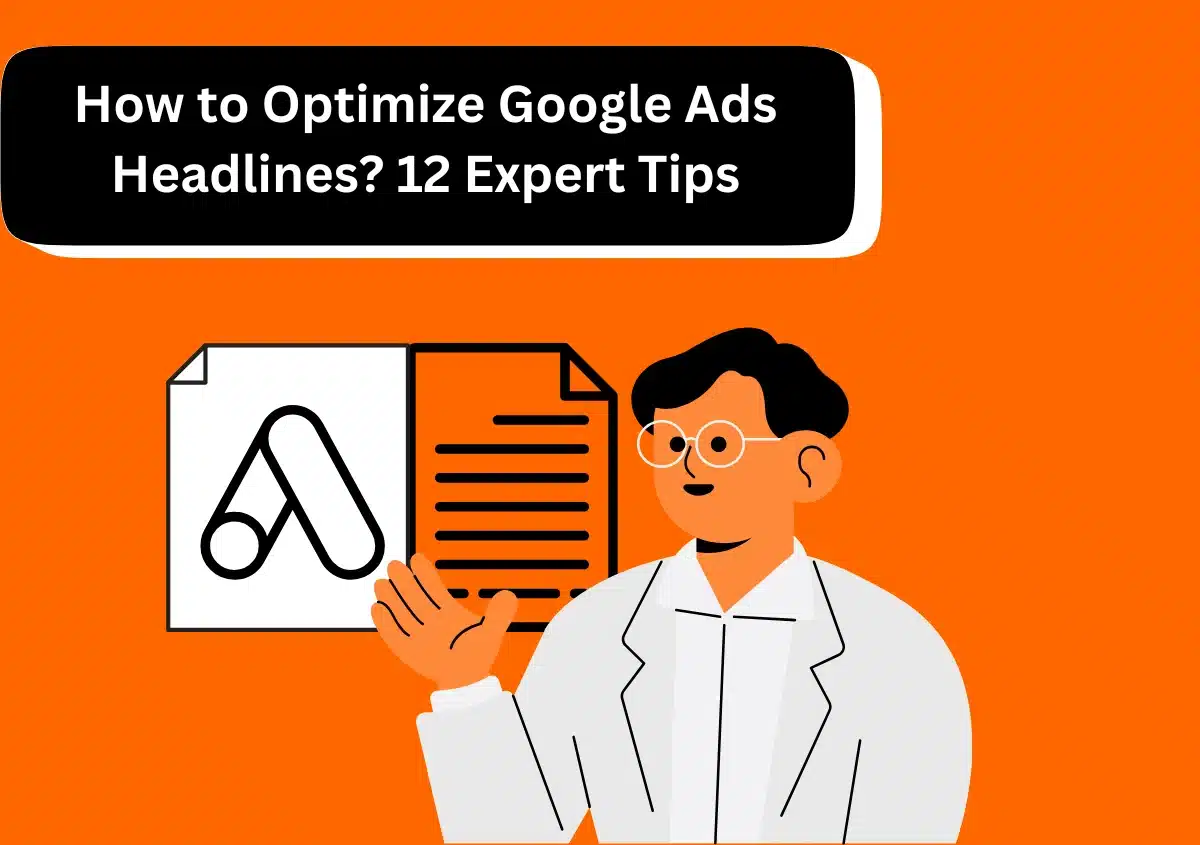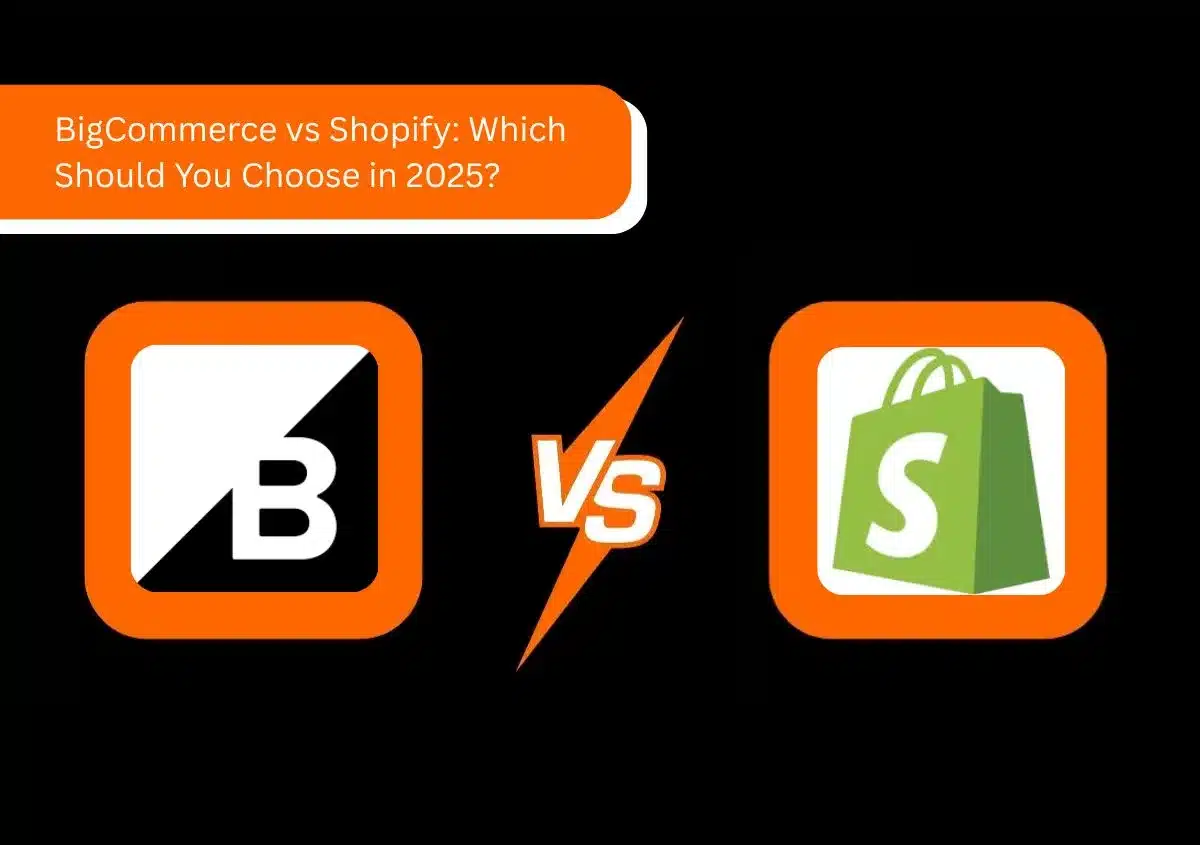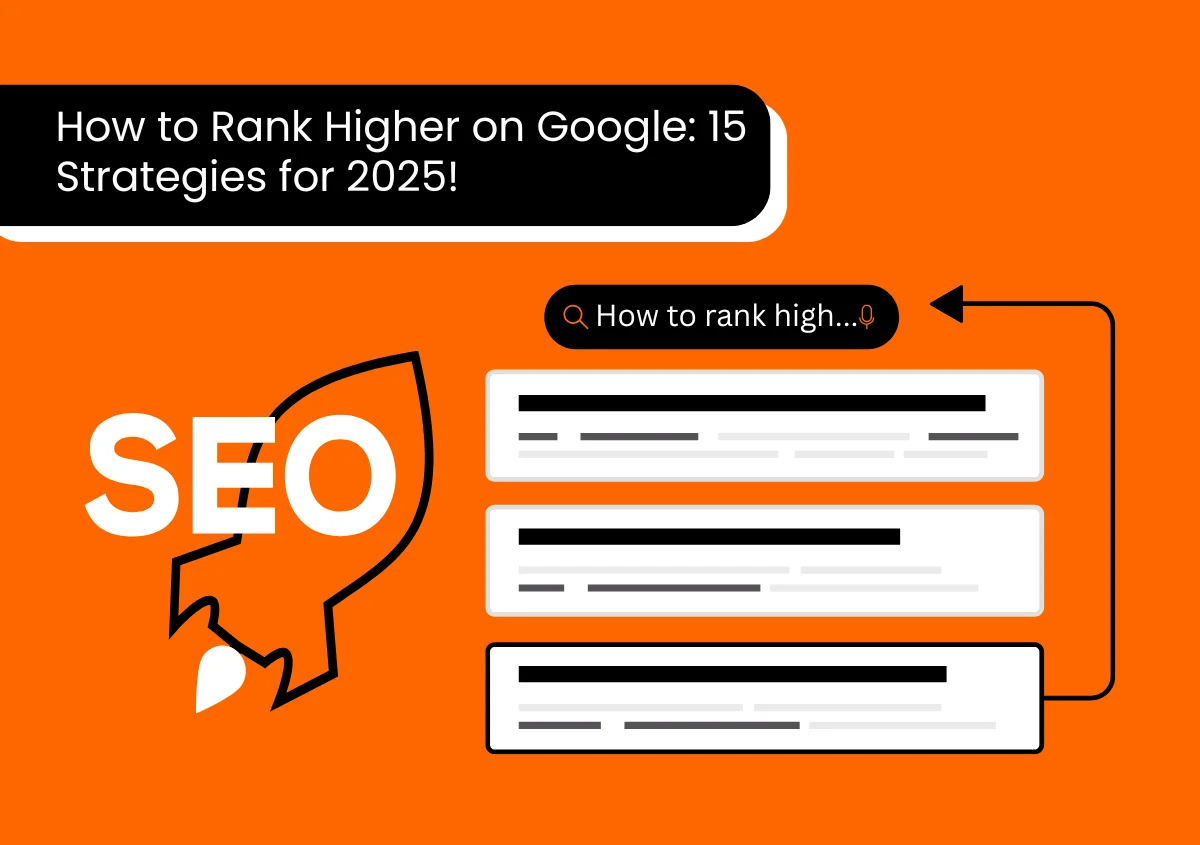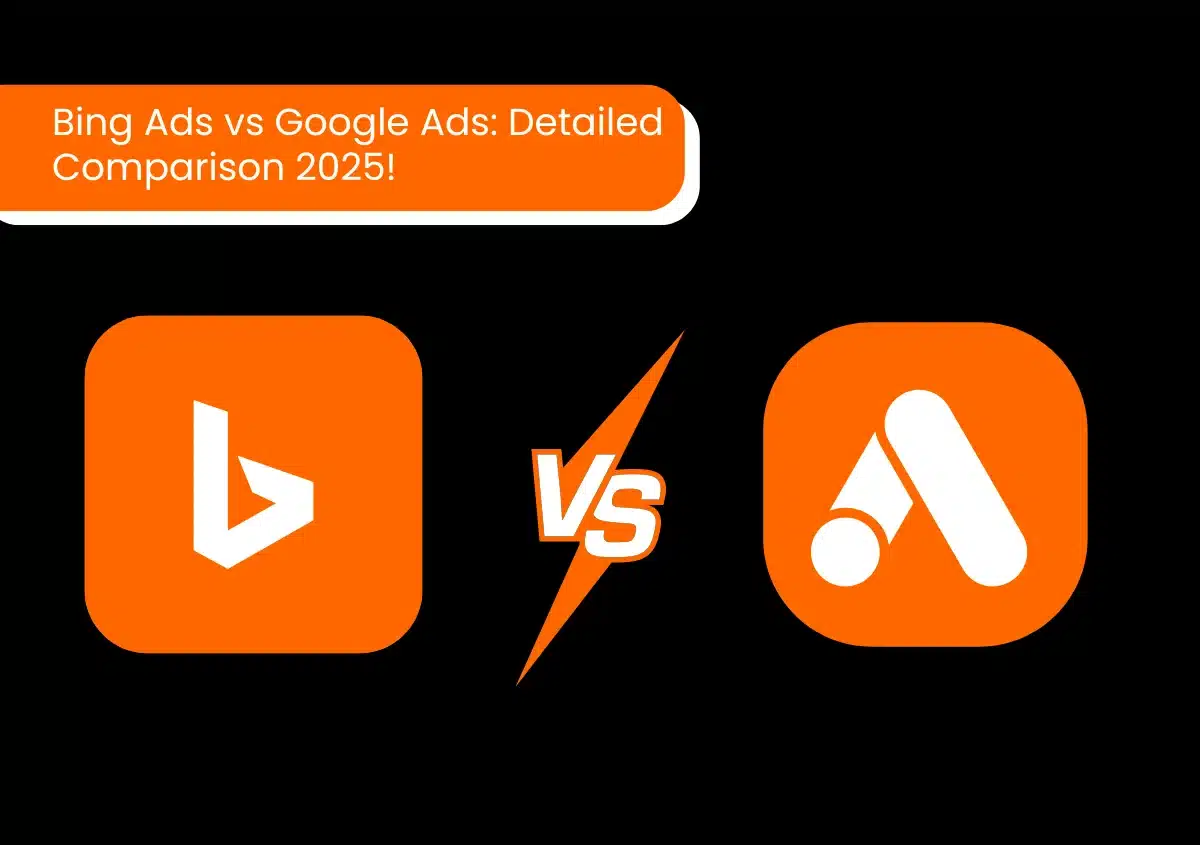Picture this: You need a specific service. So, you Google it and are scrolling through search results, glancing at ad after ad. Suddenly, you pause and maybe even click on an ad. What made you do that? That’s the power of optimized Google Ads headlines.
A compelling headline can be the difference between a click and a missed opportunity. If you are aiming to grow your sales, here’s something you must know— a carefully optimized headline not only grabs attention but drives clicks, conversions, and ultimately, sales.
Looking to improve your Google Ads? Our Google Ads specialist can create headlines that convert!
Why Do Google Ads Headlines Matter?
Google Ads headlines aren’t just words on a screen; they’re your first, and sometimes only, chance to catch the attention of a potential customer. Here’s why headlines are important:
- Increase Click-Through Rates (CTR): A well-written headline is a hook that captures attention and encourages users to click, leading to higher CTR.
- Drive Conversions: Headlines that clearly communicate value and relevance can lead to increased conversions and engagement.
Each headline must work to engage readers in seconds. Ideally, an optimized headline reflects what your ad offers and sets user expectations.
Curious to know how your ad performs? Try our PPC marketing agency for a reliable review of your Google Ads headlines.
How to Create Powerful Headlines for Google Ads?
When I say you need to optimize your Google Ads headlines, it isn’t just about words. It’s more about understanding your audience and what influences their decisions.
If you are serious about designing the best headline for Google ads, I’m sure you’ll find these tips handy:
1. Include a Strong Value Proposition
With everyone scrolling quickly, a strong value proposition can make your ad pop. Here’s what to ask yourself:
- Is it relevant to my target audience? Get straight to what matters most for your audience. This keeps their attention on your ad and makes them feel seen.
- Does it feature the right keywords? Use main keywords thoughtfully so your ad feels custom-made for the right people.
- Is it clear and concise? Aim for a headline that’s clear, to the point, and impactful. Less is often more—make every word count!
2. Keep Your Headlines Short, Clear, and Specific
Short, punchy headlines grab attention right away. Stick to a single sentence that tells your story fast and keeps it easy to understand.
Simple language is key—your audience should instantly get your message and feel tempted to click.
3. Use Action-Oriented Language
Active verbs like “Discover,” “Get,” or “Save” instantly make your offer more exciting.
These words push users to act and create a sense of urgency or reward. Trying out different action verbs can help boost engagement and clicks.
4. Ensure Organic Use of Keywords
Keywords are essential but they must feel natural in your headline. Using your main keywords smoothly increases your ad’s visibility while making it connect with what users are searching for.
Our Google Ads Management Services can help you test keywords for optimal ad performance. Contact us for expert advice!
12 Tips to Improve Google Ads Headlines and Grow Clicks
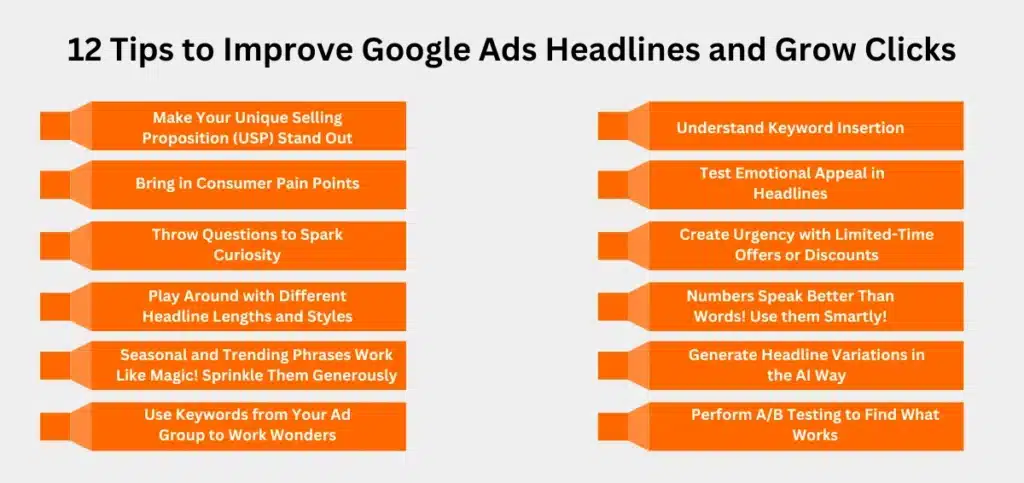
Once the basics are in place, it’s time to refine your headlines to improve ad performance and engagement. Here’s how to do it right:
1. Make Your Unique Selling Proposition (USP) Stand Out
What makes your offering unique? This USP sets you apart from competitors. Show this in your headline to immediately communicate why users should choose you over competitors.
Be specific and clear about this unique factor in your headline so users know what to expect. If you specialize in a niche, like legal services for small businesses, mention it upfront.
This directness builds immediate trust and relevance.
2. Bring in Consumer Pain Points
Addressing pain points in headlines is a proven way to connect with audiences on an emotional level.
When you show an understanding of their struggles, like “Tired of Overpriced Software?” users feel that your solution is designed for them.
Recognizing their pain points and proposing a remedy sets a tone of empathy and reliability, motivating them to explore your offering further.
3. Throw Questions to Spark Curiosity
Questions pique curiosity and engage users, especially when they reflect the common concerns or interests of the target audience.
Ask questions that resonate with common challenges, like “Want Higher ROI from Your Ads?” This makes users feel you understand their goals. It sets an expectation that clicking on your ad will lead them to valuable solutions.
Trust me, it’s a simple tactic that can dramatically increase click-through rates.
4. Play Around with Different Headline Lengths and Styles
Test various headline lengths and tones. Sometimes a longer, descriptive headline works best; other times, shorter headlines drive clicks.
How to choose between longer or shorter headlines? Here’s my pro tip—longer headlines can provide detail and clarity, which is effective when you need to convey more information. Short, punchy headlines work well to create urgency and are ideal for fast clicks.
Track the performance of headlines in different lengths to see what works for your ads.
5. Seasonal and Trending Phrases Work Like Magic! Sprinkle Them Generously
Timely phrases related to seasons or events can improve your ad’s appeal. This is a great way to catch the attention of your targeted audience when they’re most likely to be interested.
For instance, during holiday seasons, ‘Get Ready for Holiday Sales!’ or ‘Best 2024 Deals’ might capture more clicks as they’re primed to make purchases.
Plus, utilizing trends shows that your brand is aware of current interests.
6. Use Keywords from Your Ad Group to Work Wonders
Using keywords from your ad group is a simple way to make your ads more relevant. This can lead to a better quality score and even lower your cost per click (CPC).
In fact, a study by WordStream found that high-quality scores can reduce your CPC by as much as 50%—who doesn’t love saving on ad spending?
Google’s algorithm favors ads that closely match what users are searching for. You can score well here by focusing on these two factors:
- Long-tail keywords: Long-tail keywords target specific audiences and help you stand out. Instead of a broad term like ‘shirts’, try something more specific like ‘women’s formal shirts’ to connect with a niche audience.
- Negative Keywords: Negative keywords are words that tell a search engine to not show your ad when someone searches for those words. Keep updating your negative keywords, so your ads avoid irrelevant traffic and reach the right people.
7. Understand Keyword Insertion
Google’s keyword insertion feature is a great way to keep your ads relevant without constant updates. Keyword insertion customizes your ad text based on the exact terms users are searching for.
For example, use a placeholder like {Keyword: women’s formal shirts} and your ad will automatically show the exact search phrase. This way, the ad is more likely to grab users’ attention.
This is super helpful if you have a variety of products or services to promote!
8. Test Emotional Appeal in Headlines
Adding emotional appeal to your headlines can instantly grab attention and build a personal connection.
Using powerful examples like ‘Lose 10kgs in Just 30 Days!’ resonates with readers on a personal level and speaks directly to their desires or challenges.
Emotionally-driven headlines often lead to higher engagement, as they tap into real needs and motivations.
9. Create Urgency with Limited-Time Offers or Discounts
Phrases like ‘Last Day for 50% Off’ or ‘Hurry—Only a Few Spots Left!’ create a sense of urgency that drives action. These types of headlines work by sparking FOMO (Fear of Missing Out), making users feel they need to act quickly.
This approach is particularly effective for time-sensitive deals or exclusive offers, encouraging users to click before it’s too late.
10. Numbers Speak Better Than Words! Use them Smartly!
Numbers in headlines, such as ‘Save Up to 40%’ or ‘Join 5,000+ Happy Customers’, add credibility and specificity to your ad. These quantifiable elements stand out in a sea of generic text. It gives users an immediate understanding of your offer’s value.
Data-backed headlines often perform well because they promise concrete benefits. It particularly appeals to users seeking value and clarity.
11. Generate Headline Variations in the AI Way
AI tools for content generation can quickly produce multiple headline variations. The result? You get diverse options to test.
With AI, you can explore different tones, lengths, and styles in minutes. This makes it easier to identify the best-performing headlines without too much manual effort.
AI tools help optimize ad performance by continuously testing fresh ideas and adjusting to what resonates best with your audience.
12. Perform A/B Testing to Find What Works
A/B testing lets you compare different headlines to find which resonates most with your audience.
By testing two or more variations, you can gather insights into which phrases, lengths, or tones lead to the best click-through rates.
Continuously refining your ad copy is the right way to remain competitive and consistently aligned with user preferences. Don’t skip testing – it’s essential for maximizing ad performance.
Not sure what headline works best? A/B testing services from our PPC agency can reveal the answers.
Read Also: How to Use Micro Conversions for Lead Generation with Google Ads?
Why Do You Need 3 Headlines for Google Ads?
Google’s expanded text ads give you three headline fields, with each headline allowing up to 30 characters. While two headlines are required, the third is optional. These headlines appear side-by-side, separated by a vertical bar.
Here’s why using all three headlines in Google Ads can make a big difference for your campaigns:
- More Space for Key Info
With three headlines, you have more room to add value. Use this space to highlight unique selling points, such as promotions, benefits, or call-to-action phrases that grab attention right away. This extra room means your ad can say more about why users should click. - Better Ad Relevance
Google rotates and tests different headline combinations to see which performs best with your audience. By using all three headlines, you allow Google more flexibility to show the most relevant message to different users. This improves ad performance and clicks. - Visibility on More Devices
The third headline is designed to appear on wider screens, especially mobiles. This makes your ad more adaptable across devices and improves the chances of reaching users in a clear, engaging, and more professional format.
Using all three headlines can help you create ads that stand out and resonate with more people!
How to Pick Headlines for Google Ads?
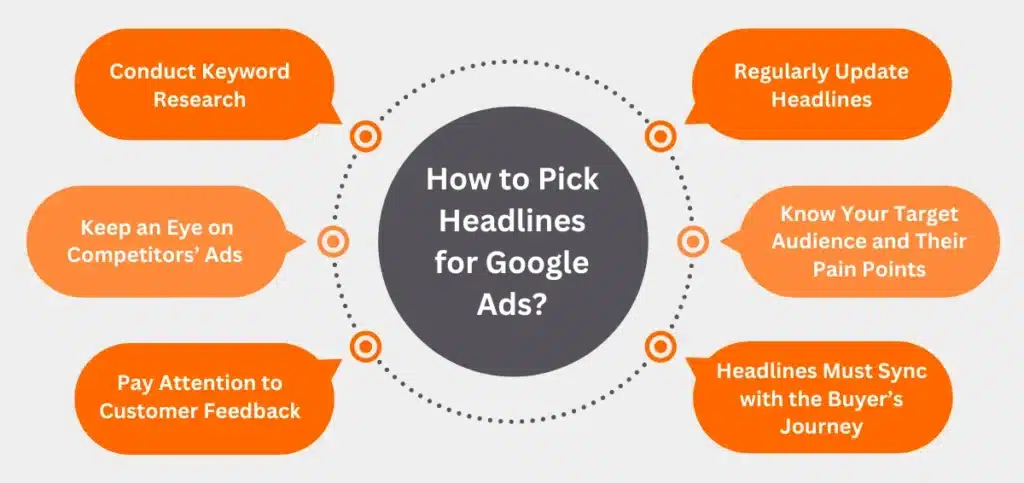
Selecting the most effective headlines can be challenging. Here’s how to make smart choices:
1. Conduct Keyword Research
Use tools like Google Keyword Planner or SEMrush to identify high-value keywords that resonate with your audience and industry. An optimized headline includes these relevant keywords to attract the right audience.
2. Keep an Eye on Competitors’ Ads
A competitive analysis can provide valuable insights. Look at Google ads headline examples from your competitors’ top-performing ads to understand their unique approaches. Look for gaps where you can stand out.
3. Pay Attention to Customer Feedback
Customer feedback can reveal what buyers find most valuable or frustrating. Directly address common questions or concerns to make your headlines more relevant.
4. Regularly Update Headlines
Evaluate your ad metrics, like CTR and conversion rates, to see which headlines perform well. Make regular updates to keep your ads optimized.
5. Know Your Target Audience and Their Pain Points
Understanding your audience and their needs is the first step to creating effective headlines.
Research your target audience, and their specific challenges or desires. Use this knowledge to design headlines that speak directly to them.
6. Headlines Must Sync with the Buyer’s Journey
Consider where your audience is in their journey. Use awareness-level headlines to introduce your brand and decision-stage headlines for stronger calls to action.
Examples of Good Google Ads Headlines
Optimize your Google Ads headline and you are sure to be amazed by how it multiplies leads, conversions, and ROI. The right headline catches attention, matches what people are searching for, and inspires action.
What Makes Some Headlines Stand Out?
Now let’s break down headlines so that you get a better idea of why some headlines work better than others. All those high-performing ads you see managed to get these basic components right:
- Relevance: Good headlines answer the audience’s search intent. They directly address user needs. For example, a headline like ‘Affordable Moving Services Near You’ appeals to local searchers looking for an affordable, reliable option.
- Keywords: Including relevant keywords does a lot more than improving ad visibility. It also tells users that the ad answers their search. A headline like ‘PPC Management Services in NYC’ ensures it shows up for users in New York City needing immediate plumbing help.
- Smart Use of Numbers: Numbers make headlines stand out and feel more credible. For instance, ‘Save 20% on Home Insurance’ immediately communicates a concrete benefit.
- Social Proof: Mentioning reviews or endorsements builds trust. An example could be ‘Rated #1 Hair Salon in Los Angeles,’ which indicates quality service.
- Call-to-Action (CTA): Phrases like ‘Get Your Free Quote’ or ‘Try Now’ are direct and actionable. It motivates users to click and engage.
- What do Customers Get: Users want to know what’s in it for them. Use a headline such as ‘Boost Your Website Traffic by 200%’ and they immediately understand what they get.
- Emotional Appeal: Tapping into emotions can create urgency. A headline like ‘Never Miss a Sale Again!’ plays with a shopper’s fear of missing out.
- Clarity: The best Google Ad headlines clearly communicate the message. A simple headline like ‘Fast, Reliable Tax Help’ gives potential customers exactly the information they need.
Real-World Examples
Now, why don’t we take a look at four real-world examples of Google Ads headlines?
1. ‘Book Your Dream Home – Affordable Luxury!’
This headline creates excitement while highlighting affordability. ‘Dream Home’ sparks emotion, and ‘Affordable Luxury’ promises the best of both worlds—exclusivity without breaking the bank.
2. ‘100+ Satisfied Clients – Join the List!’
Social proof is the star here! Proclaiming ‘100+ Satisfied Clients’ instantly builds trust, while ‘Join the List!’ invites the reader to be part of something positive and established.
3. ‘Try Our Free Consultation for Home Renovations’
Offering a ‘Free Consultation’ is a great CTA. After all, we all know how tempting the word ‘free’ can be! Plus, it’s a no-risk offer, showing that the business is reliable.
4. ‘Lose Weight Fast – Get Results in 30 Days!’
This headline invests in urgency with ‘Fast’ and credibility with ‘Get Results.’ Adding a timeframe (‘in 30 Days’) makes it feel achievable, giving potential customers a clear vision of success.
Now try to assess your current headlines against these elements. Need help? Contact our Google Ads specialists today!
Here’s to Google Ads Headlines That Convert!
Remember, optimizing Google Ads headlines is not a one-time task. It’s an ongoing process that demands creativity, analysis, and constant adjustment.
Every aspect of your headline—from CTAs to consumer insights—can affect the conversion rates.
Ready to optimize your Google Ad headlines? Contact our Google ads agency for customized solutions today.

